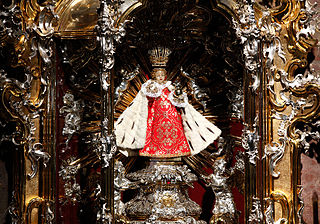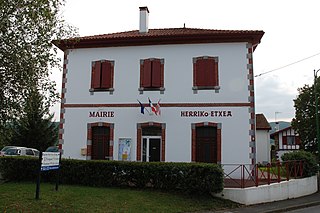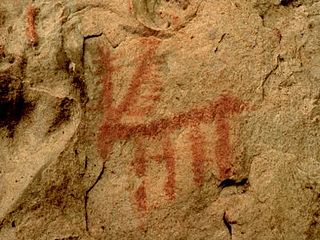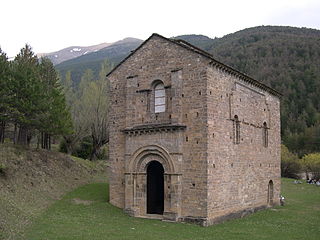
El Niño is the warm phase of the El Niño–Southern Oscillation (ENSO) and is associated with a band of warm ocean water that develops in the central and east-central equatorial Pacific, including the area off the Pacific coast of South America. The ENSO is the cycle of warm and cold sea surface temperature (SST) of the tropical central and eastern Pacific Ocean. El Niño is accompanied by high air pressure in the western Pacific and low air pressure in the eastern Pacific. El Niño phases are known to be close to four years, however, records demonstrate the cycles have lasted between two and seven years. During the development of El Niño, rainfalls develop between September–November. The cool phase of ENSO is la Niña with SST in the eastern Pacific below average and air pressure high in the eastern and low in western Pacific. The ENSO cycle, both el Niño and la Niña, causes global changes in temperature and rainfall.

Albacete is a province of central Spain, in the southern part of the autonomous community of Castile–La Mancha. As of 2012, Albacete had a population of 402,837 people. Its capital city, also called Albacete, is 262 kilometres (163 mi) by road southeast of Madrid.

The Cave of Altamira is located near the historic town of Santillana del Mar in Cantabria, Spain. It is renowned for prehistoric parietal cave art featuring charcoal drawings and polychrome paintings of contemporary local fauna and human hands. The earliest paintings were applied during the Upper Paleolithic, around 36,000 years ago. The site was only discovered in 1868 by Modesto Cubillas.

The Christ Child, also known as Divine Infant, Baby Jesus, Infant Jesus, Child Jesus, the Holy Child, and Santo Niño, refers to Jesus Christ from his nativity to age 12.

LachayNational Reserve is a protected area in the region of Lima, Peru. The reserve is located 105 kilometres (65 mi) north from the Peruvian capital, Lima, and protects part of the lomas ecosystem.

Cueva de los Casares is a cave in Riba de Saelices. Discovered in 1933, it contains a number of paleolithic cave paintings, and is most notable for a series of paintings depicting what some have argued is the earliest representation of human understanding of the reproductive process, featuring images of copulation, pregnancy, childbirth, and family life. Mammoths and other animals feature frequently in the illustrations. It was declared Bien de Interés Cultural in 1935.

Confession is the second album released by the American nu metal band Ill Niño. The album debuted at #37 in the Billboard Top 200 with first week sales of 27,863. It has been their most successful album to date. It was the last album to feature Marc Rizzo, who left during recording to join Soulfly, and also the first to feature Ahrue Luster, formerly of Machine Head.

The Santo Niño de Cebú is a Roman Catholic title of the Child Jesus associated with a religious image of the Christ Child widely venerated as miraculous by Filipino Catholics. It is the oldest Catholic relic in the Philippines, originally a gift from explorer Ferdinand Magellan to Rajah Humabon and his chief consort on account of their baptism in 1521.

Sare is a village in the traditional Basque province of Labourd, now a commune in the Pyrénées-Atlantiques department in south-western France on the border with Spain.

Izturitze is a commune in the Pyrénées-Atlantiques department in south-western France. It is located in the former province of Lower Navarre (Arberoa).

A Man Alone is a 1969 studio album by American singer Frank Sinatra, arranged by Don Costa.

Brihuega is a municipality located in the province of Guadalajara, Spain. According to the 2007 census (INE), the municipality has a population of 2,835 inhabitants.

Carennac is a commune in the Lot department in south-western France.

Juan Francisco Martínez Modesto, known as Nino, is a Spanish professional footballer who plays for Elche CF as a striker.

The Children's University Hospital of Niño Jesús is a hospital located in Madrid, Spain. It was declared Bien de Interés Cultural in 1995.

The Cave of Bacinete is a cave located in Los Alcornocales Natural Park, Los Barrios, province of Andalusia, south Spain. It contains examples of prehistoric rock art and was declared Property of cultural interest in 1985.

Bermuda: Cave of the Sharks is a 1978 Spanish-Italian-Mexican adventure-mystery film written and directed by Tonino Ricci and starring Andrés García and Janet Agren.

Valerón’s "monastery" is an archaeological site on the Spanish island of Grand Canary, in the municipality of Santa Maria de Guia, on Valerón's cliff. It is the largest pre-Hispanic collective granary built before Roman times and used by the island’s inhabitants until the conquest of the island at the end of the 15th century.

The Painted cave is an archaeological museum and park in the town of Galdar, located the northwest of Grand Canary in the Canary Islands, Spain. This centre is part of the Spanish Ministry of Culture, Historic Heritage and Museums of the town council of Grand Canary.























